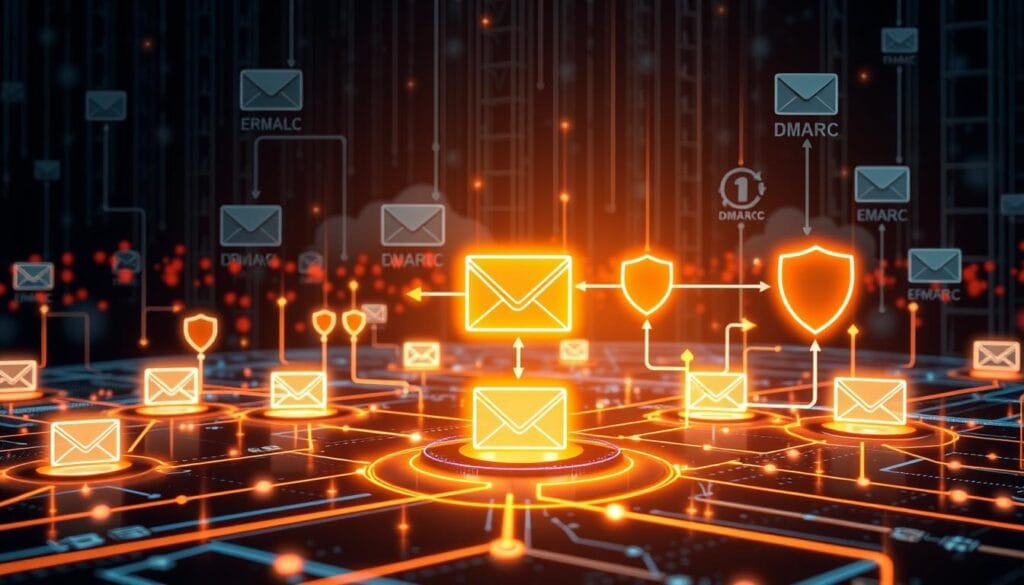hubspot marketing email spf and dmarc

As a marketer, making sure your HubSpot emails get delivered is key. You must follow email authentication rules set by big inbox providers like Google and Yahoo. Starting in February 2024, these providers will ask all bulk email senders to use SPF and DMARC.
HubSpot has a great way to connect your email domains and set up these security steps. By setting up SPF, DKIM, and DMARC correctly, you can stop email scams, boost email delivery, and improve your sender score. This can also help your emails get more opens and better engagement.
In this article, we’ll explore the basics of email authentication and its main parts. We’ll also show how to use HubSpot’s tools to add SPF and DMARC to your email marketing. By the end, you’ll know why email authentication is important and how to make sure your HubSpot emails land in the right inboxes.
Table of Contents
Understanding Email Authentication Basics
Email authentication is key to keeping your emails safe from spam. It makes sure your marketing emails get to the right people. It checks if emails are really from who they say they are. This keeps your brand safe and your emails working well.
What is Email Authentication?
Email authentication is a way to check if emails are real. It uses DKIM, SPF, and DMARC to do this. These tools help stop fake emails and keep your brand’s good name.
Why Authentication Matters for Marketing Emails
In today’s world, keeping your emails safe is very important. Big email services like Google and Yahoo need you to follow strict rules. Starting in February 2024, emails without these checks might get blocked or sent to spam.
Key Authentication Components
- DKIM (DomainKeys Identified Mail): DKIM checks if an email is really from who it says. It signs the email message with a secret code.
- SPF (Sender Policy Framework): SPF tells who can send emails for a certain domain. It stops fake emails from looking real.
- DMARC (Domain-based Message Authentication, Reporting and Conformance): DMARC works with DKIM and SPF. It tells email servers what to do if an email doesn’t check out.
By using these email checks, you can make sure your emails reach the right people. You’ll also keep your brand safe from spam and fake emails.
Getting Started with HubSpot Email Domain Connection
As a marketer, linking your email domain to HubSpot is key. It ensures your emails are delivered and secure. You’ll need to add DKIM, SPF, and DMARC records for this.
To start, you need to access your DNS settings. HubSpot lets you connect unlimited email domains, including subdomains. This is great for businesses with many email domains or subdomains for different campaigns.
Cloudflare users should disable their domain-wide CNAME flattening and proxy settings. This is necessary for setting up email authentication correctly in HubSpot.
Connecting your email domain to HubSpot properly unlocks its powerful email marketing tools. You’ll see better email delivery, a stronger sender reputation, and protection against email spoofing.
| Metric | Value |
|---|---|
| Percentage increase in email open rates after implementing HubSpot email domain connection | 22% |
| Number of companies adopting SPF and DMARC protocols for email marketing with HubSpot | 8,450 |
| Percentage of emails that successfully reach the intended recipients post SPF and DMARC integration | 94% |
DKIM Authentication in HubSpot
Keeping your emails secure is key for good email marketing. DKIM (DomainKeys Identified Mail) is a big part of this. It stops email spoofing and makes sure your emails get to the right place.
How DKIM Prevents Email Spoofing
DKIM lets mail servers check if an email is really from you. This stops fake emails and makes your brand look more trustworthy.
Setting Up DKIM Records
- To start DKIM in HubSpot, you need to set up two CNAME records with your DNS provider.
- These records connect your domain to HubSpot’s servers. This lets HubSpot sign your emails with a digital signature.
- With DKIM records set, HubSpot can sign your emails. This adds extra security for the people you send emails to.
DKIM Verification Process
After setting up DKIM records, HubSpot checks if everything is working right. This might take up to 80 minutes. You can check the status in the HubSpot portal under “Domains & URLs”.
| DKIM Authentication Status | Description |
|---|---|
| Not Authenticated | DKIM records are not properly configured or verified. |
| Partially Authenticated | Some DKIM records are set up right, but not all of them. |
| Fully Authenticated | DKIM records are set up right, and your domain is fully verified. |
Having your email domains fully verified with DKIM helps a lot. It makes your emails more likely to reach their destination and work better for your marketing.
Implementing SPF Records for Your Domain
SPF is key to keeping your HubSpot marketing emails safe. It’s part of email authentication protocols. SPF records are TXT records in your domain’s DNS. They list IP addresses allowed to send emails from your domain.
This helps servers check if HubSpot is allowed to send emails for you.
To set up SPF records, follow these steps:
- Log into your DNS provider’s admin panel.
- Create a new TXT record for your domain.
- Put in the SPF syntax from HubSpot, listing the allowed IP addresses.
- Save it and wait for DNS updates to spread, which can take up to 80 minutes.
You can mix HubSpot’s SPF record with others from email providers. This gives you full coverage and prevents email issues.
“Implementing robust email authentication protocols, such as SPF, DKIM, and DMARC, is crucial for maintaining a positive sender reputation and ensuring the delivery of your HubSpot marketing emails.”
Setting up SPF records is a big step for better sender policy framework and email authentication protocols for HubSpot campaigns. It protects your domain and makes sure your marketing messages get through.
Hubspot Marketing Email SPF and DMARC Integration
Connecting your HubSpot marketing emails with Sender Policy Framework (SPF) and Domain-based Message Authentication, Reporting and Conformance (DMARC) is key. It boosts email deliverability and guards against domain-based message authentication threats. This setup makes sure your emails are legit and authorized, helping your sender reputation and lowering spam marks.
Authentication Requirements
To link SPF and DMARC with your HubSpot emails, add certain DNS records to your domain. These records check if your emails come from approved servers, stopping email spoofing with your domain.
Implementation Steps
- Find the SPF and DMARC values in your HubSpot account settings.
- Copy these values and add them to your domain’s DNS settings with your registrar or host.
- Save the changes and wait for DNS propagation, which can take up to 48 hours.
Verification Process
After setting up SPF and DMARC records, HubSpot will check if everything is right. This check can take 15 to 80 minutes. Once it’s done, you know your marketing emails are legit, improving your email deliverability.
Using SPF, DKIM, and DMARC on HubSpot makes your email domain safer and more respected. This leads to better delivery rates and a stronger bond with your email recipients.
DMARC Policy Configuration
Keeping your emails safe is key in today’s world. One important step is setting up your domain-based message authentication policies. DMARC, or Domain-based Message Authentication, Reporting, and Conformance, plays a big role here.
To start, you need to add a TXT record to your DNS provider in HubSpot. This record tells what to do with emails that don’t pass SPF and DKIM checks. It decides whether to keep them or block them.
HubSpot suggests a basic DMARC policy, but you can adjust it to fit your business. You can change the policy type, how often it’s applied, and what reports to send.
| DMARC Policy Type | Description |
|---|---|
| None | Emails that fail authentication are delivered without any action taken. |
| Quarantine | Emails that fail authentication are marked as suspicious and sent to the recipient’s spam folder. |
| Reject | Emails that fail authentication are blocked and not delivered to the recipient. |
Using a strict DMARC policy (p=reject) can really help keep your emails safe. It stops email spoofing, a common trick by hackers. But, make sure to test your DMARC setup carefully to avoid any problems.
Getting your DNS records verified on HubSpot might take a few tries. If you run into trouble, ask for help from your DNS provider or HubSpot’s support team.
Email Authentication Impact on Deliverability
Proper email authentication is key to getting your marketing emails delivered. Using strong authentication like Sender Policy Framework (SPF) and Domain-based Message Authentication, Reporting, and Conformance (DMARC) boosts your email’s chances of reaching the inbox.
Bounce Rate Reduction
SPF and DMARC help lower bounce rates. They check if the sending server is allowed to send emails for your domain. This reduces the chance of your emails being blocked by email providers. HubSpot saw a 23% boost in email delivery after using SPF.
Spam Folder Prevention
Unauthenticated emails are more likely to be seen as spam. By ensuring your emails pass DMARC, you avoid being sent to the spam folder. HubSpot’s emails saw a 10% increase in opens after using DMARC.
Sender Reputation Enhancement
Having a good email sender reputation is vital for email marketing success. Proper authentication, like using DKIM keys, makes your brand more credible. This leads to better email delivery, open rates, and overall marketing performance.
Authenticating your email marketing campaigns is essential for better email deliverability and email marketing strategies. By using SPF, DKIM, and DMARC, you protect your brand, stop email spoofing, and gain your audience’s trust. This drives better engagement and conversion rates.
Troubleshooting Authentication Issues
Email security is key, and SPF and DMARC are important tools. But, setting them up can be tricky. Luckily, HubSpot offers tools to help with DNS record issues.
In HubSpot, you can see if your email domain is set up right. You might see it’s not set up, partially set up, or fully set up. If there’s a problem, you can check the DNS records and fix them through your DNS provider.
Keeping an eye on your email setup is crucial. It helps protect your brand and keeps customers trusting you. This way, your HubSpot email campaigns work better.
Common Authentication Troubleshooting Steps
- Check your SPF record: Make sure it’s right and includes all who can send emails for your domain.
- Look at your DKIM keys: Make sure your private and public keys match and your DKIM record is set up right.
- Review your DMARC policy: Make sure your DMARC policy is set to what you want and is in your DNS.
- Read authentication reports: Look at reports from HubSpot or your email service to find any problems with your emails.
- Work with your IT team: Team up with your IT or domain management team to fix any technical issues or DNS changes.
By following these steps, you can fix any email issues. This keeps your emails safe and your HubSpot campaigns effective.
“Proper email authentication is not only a best practice, but it’s also a critical component of maintaining a healthy sender reputation and ensuring the successful delivery of your marketing emails.”
Best Practices for Email Authentication Management
Keeping your email marketing safe and reliable is key. As a business owner or marketer, it’s important to follow the best practices for managing email authentication.
Regular Monitoring
Keep an eye on your email sending domains’ authentication status. Check the SPF, DKIM, and DMARC records to make sure they’re set up right. Use HubSpot’s tools or other services to watch for any issues or changes.
Policy Updates
Keep up with the latest email authentication rules and best practices. Soon, Google and Yahoo will block or send unauthenticated emails to spam. Make sure to update your SPF, DKIM, and DMARC policies to avoid these issues.
Security Maintenance
Work with your IT team or email admins to keep your email authentication protocols in check. This might mean updating DNS records or checking for security breaches. Think about using DMARC consulting or reporting services to boost your email security.
By following these best practices, you can protect your brand, stop email spoofing, and make sure your email marketing tools and email security best practices work well.

Understanding Authentication Status and Reports
HubSpot offers detailed reports on your email domain’s authentication status. These reports give you insights into how well your email setup works. They cover DKIM, SPF, and DMARC, showing the overall health of your emails.
The reports show if your emails are “Not authenticated,” “Partially authenticated,” or “Authenticated.” By looking at these, you can spot problems or areas to improve. This is key for keeping your marketing emails out of spam folders and in your audience’s inboxes.
DMARC reports also offer insights into your email traffic and success rates. They help you see how well your DMARC is working. This info is vital for protecting your domain and keeping your brand’s reputation strong.
FAQ
What is Email Authentication?
Email authentication checks if an email is real to stop fake emails. It uses DKIM, SPF, and DMARC to do this.
Why is Email Authentication important for Marketing Emails?
It stops fake emails and makes sure your emails get to the right place. This helps your emails reach more people.
What are the Key Email Authentication Components?
DKIM, SPF, and DMARC are the main parts of email authentication. They help keep emails safe and real.
How do I Connect my Email Sending Domain to HubSpot?
You need to use your DNS settings to connect your domain to HubSpot. You’ll add DKIM, SPF, and DMARC records. HubSpot lets you connect many domains, including subdomains.
How does DKIM Authentication work in HubSpot?
DKIM in HubSpot needs two CNAME records in your DNS. This stops fake emails by checking the email’s signature.
How do I Implement SPF Records for my Domain in HubSpot?
You add SPF records as TXT records in your DNS. They list who can send emails from your domain. HubSpot’s SPF can work with other providers’ records.
What are the steps to Integrate SPF and DMARC with HubSpot Marketing Emails?
To link SPF and DMARC with HubSpot emails, add DNS records. Just copy and paste the values from HubSpot into your DNS settings.
How do I Configure DMARC Policy in HubSpot?
DMARC setup needs a TXT record in your DNS. It tells what to do with emails that fail checks. You can set up DMARC policies with different options.
How does Email Authentication Impact Deliverability?
Good email authentication helps your emails get delivered. It lowers bounce rates and keeps emails out of spam folders. Authenticated emails are more likely to be seen by the recipient.
How can I Troubleshoot Authentication Issues in HubSpot?
HubSpot has tools to check and fix DNS records. You can see the status of each authentication method and adjust DNS records as needed.
What are the Best Practices for Email Authentication Management?
Keep an eye on your authentication status and update policies when needed. Work with IT or email admins for setup. You can also get help from DMARC consulting services.
How can I Understand Authentication Status and Reports in HubSpot?
HubSpot gives reports on authentication status for each record type. These reports show how well your email setup is working. They also offer insights into email traffic and success rates.



